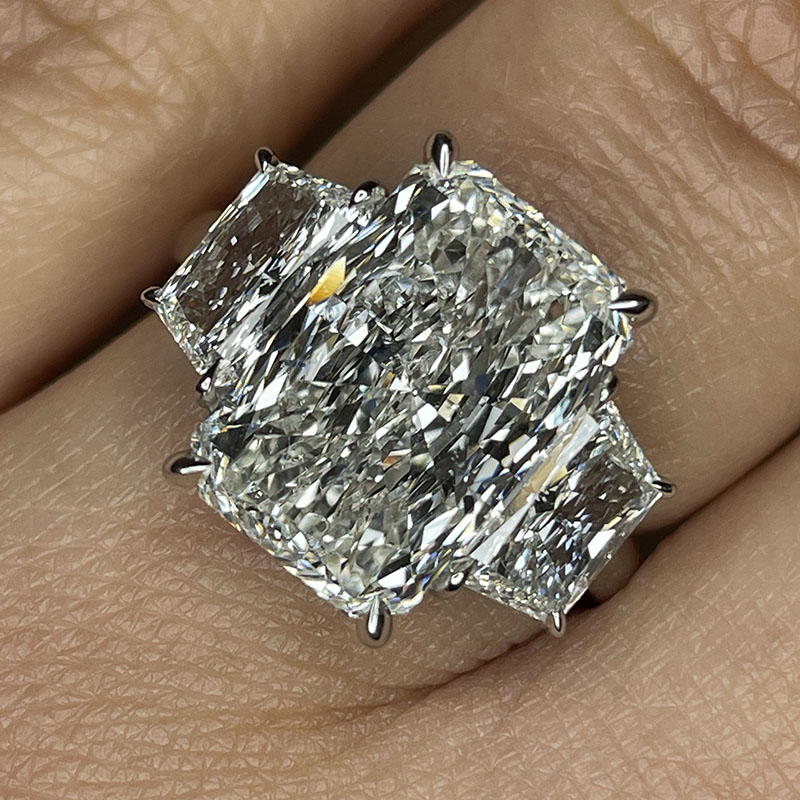In the dazzling world of diamonds, where brilliant rounds often steal the spotlight, a multitude of fancy shapes patiently await their moment to shine. Among these, the trapezoid cut diamond stands as a testament to geometric elegance and sophisticated design. Often serving as a captivating complement to a larger center stone, or occasionally asserting its unique presence as a solitaire, the trapezoid cut offers a distinctive blend of modern architectural lines and timeless allure. This article delves into the fascinating world of trapezoid cut diamonds, exploring their unique characteristics, their role in fine jewelry, and what makes them a truly exceptional choice for the discerning connoisseur.
What Exactly is a Trapezoid Cut Diamond?
At its core, a trapezoid cut diamond is a four-sided gemstone with two parallel sides and two non-parallel sides. This geometric definition gives it its characteristic tapered shape, which sets it apart from more common rectangular or square cuts. While the term "trapezoid" broadly describes this form, in the diamond industry, it often refers to a specific type of fancy cut that is intentionally designed to complement other diamond shapes, particularly those with straight edges like emerald, radiant, asscher, or princess cuts.
It’s crucial to distinguish trapezoids from similar-looking cuts like tapered baguettes or shield cuts. A tapered baguette is typically much more elongated and slender, with very subtly angled sides, often resembling a very thin trapezoid. A shield cut is broader and can have more rounded or curved non-parallel sides, resembling a medieval shield. The trapezoid, however, maintains its distinct angularity and balanced proportions, making it incredibly versatile.
Trapezoid diamonds come in two primary faceting styles:
- Step-Cut Trapezoids: These feature parallel, rectangular facets that run along the length of the diamond, creating a "hall of mirrors" effect. Like emerald or asscher cuts, step-cut trapezoids emphasize clarity and the diamond’s natural color, producing broad flashes of light rather than intense sparkle. Their crisp, clean lines lend themselves to a more classic, understated elegance, reminiscent of Art Deco aesthetics.
- Brilliant-Cut Trapezoids: These are faceted with numerous triangular and kite-shaped facets, similar to a round brilliant diamond. This faceting style maximizes light return, resulting in a more fiery and scintillating appearance. Brilliant-cut trapezoids are often chosen when the goal is to enhance the sparkle of a brilliant-cut center stone, or when a more lively, effervescent look is desired.
The choice between a step-cut and a brilliant-cut trapezoid largely depends on the desired aesthetic and the center stone it will accompany. A step-cut trapezoid pairs beautifully with an emerald or asscher cut, creating a harmonious and sophisticated trio. A brilliant-cut trapezoid, on the other hand, is the perfect partner for a radiant, cushion, or even a round brilliant, amplifying the overall sparkle and brilliance of the piece.
The Allure and Versatility in Design
The true magic of the trapezoid cut lies in its unparalleled versatility, particularly as a side stone. Its tapered shape allows it to seamlessly transition from a larger center stone to the band, creating a visually pleasing and elegant flow.
- Three-Stone Rings: This is perhaps the most classic application for trapezoid diamonds. Flanking a magnificent emerald, radiant, or princess cut center stone, two perfectly matched trapezoids can dramatically enhance its presence. They draw the eye inward, making the center stone appear larger and more prominent, while adding a touch of geometric sophistication. The parallel sides align perfectly with the center stone, and the tapered sides gently guide the eye along the ring’s band.
- Unique Solitaires: While less common, a single, well-proportioned trapezoid can make an incredibly striking solitaire ring. This choice speaks to an individual who values unique design and architectural beauty over traditional sparkle. The clean lines and distinct shape of a trapezoid solitaire offer a modern, minimalist aesthetic that is both bold and elegant.
- Five-Stone Rings and Beyond: Trapezoids can also be incorporated into more elaborate designs. In a five-stone ring, they might alternate with other fancy shapes or even smaller round brilliants, creating an intricate pattern. They can also feature in bespoke pendants, earrings, or even eternity bands, where their repeating geometric form creates a captivating visual rhythm.
- Art Deco Influence: The geometric precision and clean lines of the trapezoid cut resonate strongly with the Art Deco movement of the 1920s and 30s. This era celebrated symmetry, bold shapes, and architectural elegance, making trapezoid diamonds a natural fit for vintage-inspired designs or contemporary pieces seeking a touch of retro glamour.
Key Considerations When Choosing a Trapezoid Diamond
Selecting a trapezoid cut diamond requires a keen eye and a thorough understanding of diamond characteristics, as their unique shape presents specific considerations beyond the traditional 4Cs (Carat, Color, Clarity, Cut).
- Symmetry is Paramount: For any fancy shape, symmetry is crucial, but for trapezoids, it is exceptionally important. Because they are often used in pairs, perfect symmetry between the two stones is non-negotiable. Uneven angles, slightly different lengths of parallel sides, or mismatched tapers will be immediately noticeable and detract from the overall beauty of the piece. Even for a solitaire, good symmetry ensures a balanced and appealing shape.
- Matching (for side stones): When buying a pair of trapezoids for a three-stone ring, matching goes beyond just symmetry. They must also be perfectly matched in color, clarity, and brilliance. Any discrepancy, no matter how subtle, can disrupt the visual harmony of the ring. This often means sourcing diamonds from the same rough stone or from a highly curated selection.
- Proportions and Shape Appeal: Unlike round brilliants which have strict ideal cut parameters, fancy shapes like trapezoids rely more on "shape appeal" – how aesthetically pleasing their unique proportions are. The length-to-width ratio, the angle of the non-parallel sides, and the overall depth of the stone will all influence its visual impact. There are no fixed rules, but generally, a trapezoid should not be too broad or too narrow, and its taper should be graceful and well-defined.
- Color: Trapezoids, especially step-cut variations, can show color more readily than brilliant cuts. If pairing with a high-color (D-F) center stone, it’s essential that the trapezoid side stones also be of comparable color grades to avoid a noticeable contrast. Brilliant-cut trapezoids can be slightly more forgiving due to their increased sparkle.
- Clarity: For step-cut trapezoids, clarity is critical. The large, open facets act like windows, making inclusions more visible. Therefore, a higher clarity grade (VS2 or better) is generally recommended. Brilliant-cut trapezoids, with their numerous facets, can hide minor inclusions more effectively, allowing for slightly lower clarity grades (SI1 or SI2) depending on the nature and location of the inclusion.
- Certification: While major labs like GIA and AGS do grade fancy shapes, their cut grades are not as detailed or standardized as for round brilliants. For trapezoids, the certificate will primarily confirm the 4Cs, dimensions, and polish/symmetry. It’s crucial to rely on a reputable jeweler who specializes in fancy shapes and can visually assess the cut quality and shape appeal.
The Craftsmanship Behind the Cut
Cutting a trapezoid diamond requires exceptional skill and precision. The cutter must not only consider the traditional goal of maximizing brilliance and minimizing waste but also meticulously plan the angles and proportions to achieve the distinct tapered shape with perfect symmetry. This often means sacrificing more of the rough diamond compared to cutting a standard shape, which can contribute to their relative rarity and specialized appeal. The ability to create a perfectly matched pair of trapezoids from a single rough stone is a testament to the cutter’s artistry and expertise.
Why Choose a Trapezoid Cut Diamond?
Choosing a trapezoid cut diamond is a statement of refined taste and a departure from the conventional. It appeals to those who:
- Seek Individuality: They desire a diamond that stands out from the crowd without being overly ostentatious.
- Appreciate Geometric Beauty: The clean lines and precise angles appeal to a modern, architectural aesthetic.
- Value Complementary Design: They understand how the right side stones can elevate and transform a center stone into a cohesive work of art.
- Are Inspired by History: The Art Deco resonance offers a touch of timeless glamour and sophisticated nostalgia.
- Desire Versatility: They appreciate a cut that can be elegant, modern, or vintage-inspired, depending on the setting.
In conclusion, the trapezoid cut diamond, though often playing a supporting role, is far from a secondary character. It is a sophisticated, versatile, and visually striking gemstone that brings an unparalleled sense of balance, elegance, and modern flair to any piece of jewelry. Its unique geometry and the artistry required to cut it make it a truly special choice for those who appreciate the subtle nuances and enduring beauty of fancy shape diamonds. Whether framing a magnificent solitaire or shining as a standalone statement, the trapezoid cut diamond is a testament to the fact that true beauty often lies in the art of angles and the mastery of understated design.


